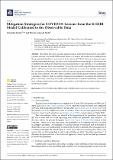Mitigation Strategies for COVID-19: Lessons from the K-SEIR Model Calibrated to the Observable Data
Author(s)
Lipton, Alexander; de Prado, Marcos Lopez
Downloadjrfm-15-00248.pdf (2.984Mb)
Publisher with Creative Commons License
Publisher with Creative Commons License
Creative Commons Attribution
Terms of use
Metadata
Show full item recordAbstract
This article develops a detailed epidemiological multi-factor model, the K-susceptible–exposed–infected–removed (K-SEIR) model, and several simpler sub-models as its building blocks. The general model enables us to account for all the relevant COVID-19 features, its disparate impact on different population groups, and interactions within and between the groups. It also includes the availability (or lack thereof) of spare hospital beds and intensive care units (ICU) to accommodate the pent-up demand due to the pandemic. We use the most recent hospitalization and mortality data to calibrate the model. Since our model is multi-factor, we can use it to simulate and analyze the consequences of the sheltering-in-place for each specific group and compare the lives saved and lost due to this measure. We show that in countries with well-developed healthcare systems and a population willing to abide by suitable containment and mitigation procedures, the sheltering in place of the entire community is excessive and harmful when considered holistically. At the same time, sealing nursing homes as thoroughly as possible to avoid high infection and mortality rates is an absolute necessity.
Date issued
2022-06-01Department
MIT Connection Science (Research institute)Publisher
Multidisciplinary Digital Publishing Institute
Citation
Journal of Risk and Financial Management 15 (6): 248 (2022)
Version: Final published version